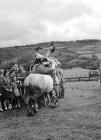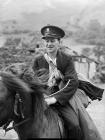Geoff Charles, Photojournalist
Items in this story:
Geoff Charles
The more observant among you may have noticed a number of photographs on the site belonging to the photographer, Geoff Charles (1909-2002). His contribution to Welsh photography is unique and provides a fascinating snapshot of Welsh life between the 1930s and 1970s when Charles worked as a photojournalist. During his career, Geoff Charles portrayed life in Wales through the lens of a camera and his collection of 120,000 negatives is one of the treasures of The National Library of Wales.
Born in Brymbo in 1909, Geoff Charles studied for a Diploma in Journalism at the University of London, graduating with first class honours in 1928. He began his career at the Western Mail, reporting on dirt track racing, greyhounds and inquests. After a short while, he moved to the Mountain Ash and Aberdare Express before crossing the border to work at the Surrey Advertiser in Guildford.
Following a serious bout of illness, Geoff Charles returned to his native area and began working at the Wrexham Star, a paper established on a shoestring budget in February 1934. The paper was sold at a penny in an attempt to undercut the Wrexham Leader which sold for twopence.
Gresford
The Gresford Colliery Disaster was one of the first incidents that Geoff Charles covered during his time at theStar and could be seen as a defining moment in his career. Having gained access to the lamp room, he discovered that the official figure of 100 men underground was an understatement and he rushed back to the newsroom to publish a special edition of the paper. It was during his time at he Wrexham Star that Geoff bought his first camera, a VPK Thornton Pickard using 6 x 9 cm (2.5 x 3.5 inch) glass plates. That was the beginning of his photographic career which would produce so many memorable images.
In March 1936 the Wrexham Star was amalgamated with the Wrexham Advertiser and from there Charles was appointed manager of the photographic section of Woodalls Newspapers by Rowland Thomas, the managing director. This took him to Newtown where he ran the Montgomeryshire Express.
Iconic Images
It is perhaps for his work with Y Cymro that Geoff Charles is best known. This began in 1937 after he met a young reporter called John Roberts Williams during his time at the Montgomeryshire Express. He began illustrating Williams’ articles, photographing the Reverend Lewis Valentine shortly before he was imprisoned for his part in the burning of the Penyberth Bombing School in September 1936.
Geoff Charles’ work for Y Cymro began in earnest after the Second World War when John Roberts Williams was appointed editor. This partnership was to produce photojournalism that had never been seen in Wales before. It was reminiscent of the prominent Picture Post magazine and Geoff Charles made no secret that the magazine’s striking images were a source of inspiration to him in his work.
His work succeeded in capturing Welsh life in an empathetic and sympathetic way; not only the significant historical events of the age, but also the day-to-day life of the people of Wales. His photographs capture the imagination of the nation, perhaps none more so that that of the farmer-poet Carneddog and his wife who were forced to leave their home in the Carneddau Mountains due to the death of their son. It is said that this iconic image resonated so deeply with many Welsh people that it was sometimes found pinned next to Curnow Vosper’s “Salem”.
Equally, if not more, significant is that Charles’ photographs documented a way of life that was vanishing. The changes that followed the Second World War meant that traditional Welsh ways of life were disappearing; the shearing of sheep by hand, the postman delivering his letters on horseback or the tradition of collecting Calennig each new year. Geoff Charles’ determination and attention to detail meant that these daily, seemingly insignificant tasks and occurrences were documented in his unmistakable black and white photographs.
Tryweryn
Perhaps his most famous collection of photographs is the weeks and months leading up to the flooding of the Tryweryn Valley. Life in the valley was typical of so many others in Wales at that time but it was under threat and was eventually drowned to make a reservoir to supply Liverpool. In the weeks before the inhabitants were forced to leave, Geoff Charles, with characteristic meticulousness, recorded each and every aspect of life in the village of Capel Celyn and the surrounding farmsteads, as well as the continued efforts to save the valley from its fate.
These photographs form part of the collection of 120,000 glass negatives he donated to The National Library of Wales after he retired in 1975. His work has become a priceless resource, and his crisp, natural photographs provide an invaluable insight into life in Wales during the middle of the twentieth century.


